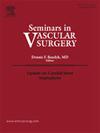Charcot neuroarthropathy: Surgical and conservative treatment approaches
IF 2.4
3区 医学
Q1 PERIPHERAL VASCULAR DISEASE
引用次数: 0
Abstract
Charcot neuroarthropathy (CN) is an inflammatory condition affecting the joints of patients with peripheral neuropathy; its prevalence is as high as 7.5%. It is commonly seen in patients with diabetes and poses a significant public health burden. CN often leads to severe morbidity, with complications including ulcerations, infections, and lower extremity amputations, and a 5-year mortality rate of 29.0%. The etiology of this condition is a combination of inflammation, neurotrauma, and altered bone metabolism, necessitating early identification and accurate diagnosis through clinical evaluation and imaging studies. Conservative management, particularly total contact casting, plays a pivotal role in managing midfoot ulcers, demonstrating success in reducing plantar pressure and promoting ulcer healing. Surgical interventions are aimed to stabilize affected joints through techniques like arthrodesis and osteotomy and creating a plantigrade foot. Reconstructive options, including external and internal fixation, play a crucial role in the healing process. Postoperative management, including rehabilitation, is vital for successful outcomes, with surgical success rates varying based on procedures. CN is often misdiagnosed as gout, deep vein thrombosis, cellulitis, or infection, and diagnosis is often delayed in the acute care setting. Early diagnosis and intervention can significantly improve outcomes for these patients.
Charcot神经关节病:手术和保守治疗方法
Charcot神经关节病(CN)是一种影响周围神经病变患者关节的炎症性疾病;其患病率高达7.5%。它常见于糖尿病患者,并造成重大的公共卫生负担。CN常常导致严重的发病率,并发症包括溃疡、感染和下肢截肢,5年死亡率为29.0%。这种疾病的病因是炎症、神经创伤和骨代谢改变的结合,需要通过临床评估和影像学检查早期识别和准确诊断。保守治疗,特别是全接触铸造,在治疗足中部溃疡中起着关键作用,在减少足底压力和促进溃疡愈合方面取得了成功。手术干预的目的是通过关节融合术和截骨术等技术来稳定受影响的关节,并创造跖足。重建选择,包括外固定和内固定,在愈合过程中起着至关重要的作用。术后管理,包括康复,对于成功的结果是至关重要的,手术成功率因手术过程而异。CN经常被误诊为痛风、深静脉血栓、蜂窝织炎或感染,并且在急性护理环境中诊断经常被延迟。早期诊断和干预可以显著改善这些患者的预后。
本文章由计算机程序翻译,如有差异,请以英文原文为准。
求助全文
约1分钟内获得全文
求助全文
来源期刊
CiteScore
3.50
自引率
4.00%
发文量
54
审稿时长
50 days
期刊介绍:
Each issue of Seminars in Vascular Surgery examines the latest thinking on a particular clinical problem and features new diagnostic and operative techniques. The journal allows practitioners to expand their capabilities and to keep pace with the most rapidly evolving areas of surgery.

 求助内容:
求助内容: 应助结果提醒方式:
应助结果提醒方式:


